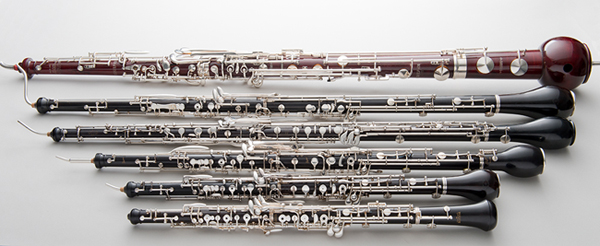- Instruments, Bocals, Tools for Sale
- Instrument Hot List
- Rare Saxophone Registry
- A Philosophy of Oboes
- Buying an Oboe
- Oboe Makers & Commentary
- "Stencil" Instruments
- Alternate Fingerings
- Care of Oboes & English Horns
- Consignment
- Contact - Payment - Shipping
- Heckelphone/Bass Oboe
Repertoire - 1966 Oboe Music Catalog
- McGinnis & Marx - Home
Peter Hurd
360.671.0696
10:00 am - 5:00 pm
Monday - Saturday, Pacific Time
peteroboe1@gmail.com
info@oboes.us
In-person visits to try instruments welcome - please make an appointment in advance
USPS:
P.O. Box 30826
Bellingham , WA 98228 USA
USPS WILL NOT DELIVER TO OUR PHYSICAL ADDRESS
UPS/FedEX/DHL:
4371 Gooding Ave.
Bellingham , WA 98226 USA

Baritone Sax-oboe in Eb, Cabart,the only known example.
Always buy the instrument, NOT the name on the instrument! Almost every oboe maker (with some exceptions) has made at least some exquisite instruments. Some makers of course, such as Loree, have produced a higher percentage of excellent instruments.
A few years ago, I was advising a father in California who was looking for a first class oboe for his 16 year old daughter. At the time, I did not have any instruments from my collection I felt would suffice. When speaking to the father, I could hear his daughter saying in the background "it MUST BE a Loree!" After a couple of weeks passed, I received another call from the father. His daughter had managed to assembled a collection 5 new Loree oboes from dealers to try- 2 "Royal", plus 1 "AK", and 2 "regular bore" instruments. "Is this the correct approach?" he asked. I replied that if I were in his position that I would compare the lot of Loree oboes to a used Hiniker oboe for sale on consignment at Midwest Musical Imports. So the father arranged to have the Hiniker sent out for trial as well. About a week later, the father called again saying "we bought the Hiniker! It was NO contest. The Hiniker oboe `sings!'"
One other oboe history: A few years ago, I ventured to Vancouver, BC to spend a day at master repairman Robert ("Bob") MacDonald's repair bench.
Bob enjoys talking to his clients while he works. After some time sitting next to Bob, I spotted a familiar looking case on the far side of bench. I picked up the case, opened it, and discovered a brand new Loree "Royale" Rosewood oboe with gold keys. I asked Bob if I could "give it a go". Bob said "of course- I would like to have your opinion. I plugged in a reed and played for a few minutes. I turned to Bob and said "this is in fact THE worst oboe I have ever played!" Bob replied "yes, this is my opinion also, but I am still determined to try to salvage it!" After another hour, I needed to stretch, so I walked about the shop. Passing Bob's apprentice's bench, I noticed a familiar looking oboe on a peg. I picked it up and discovered that it was a "BW" series (Storch) Chauvet oboe. Bob's apprentice had just finished a complete overhaul. I asked Bob if I could play the oboe. "Sure." I played the first 30 or so bars of the Strauss Oboe Concerto. The instrument just about "played itself." I said to Bob "this is easily THE finest oboe I have ever played!" Bob replied "yes, it is fantastic, and would you believe that it belongs to the same person who owns the Loree Royal!"
Back in the early 1990's my friend Glen Danielson (English horn, Seattle Symphony) bought a brand new Laubin English horn. After set up by Bob McDonald, and revoicing of the E, the horn in fact was sensational, and Glen used this instrument from new until his retirement in 2005. When the instrument was about a year old, Glen and I spent an afternoon comparing his new Laubin to two "AC" series Chauvet English horns from my collection in an extensive "blind" test.
After three hours, both Glen and I came to the conclusion that the instruments were for all intents and purposes identical with respect to voicing, timbre- the "dark, chocolaty, velvet sound", and scale. As an afterthought, Glen said that he felt that "the Laubin had perhaps about 10%- 15% less projection than the two Chauvet English horns."

From top to bottom: Heckelphone, Loree bass oboe, Cabart baritone sax-oboe in Eb,
Puchner English horn, Loree oboe d'amore, Hiniker oboe